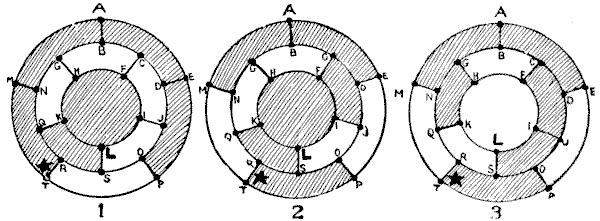
THE MOTOR-CAR TOUR.—solution
First of all I will ask the reader to compare the original square diagram with the circular one shown in Figs. 1, 2, and 3 below. If for the moment we ignore the shading (the purpose of which I shall proceed to explain), we find that the circular diagram in each case is merely a simplification of the original square one—that is, the roads from A lead to B, E, and M in both cases, the roads from L (London) lead to I, K, and S, and so on. The form below, being circular and symmetrical, answers my purpose better in applying a mechanical solution, and I therefore adopt it without altering in any way the conditions of the puzzle. If such a question as distances from town to town came into the problem, the new diagrams might require the addition of numbers to indicate these distances, or they might conceivably not be at all practicable.

Now, I draw the three circular diagrams, as shown, on a sheet of paper and then cut out three pieces of cardboard of the forms indicated by the shaded parts of these diagrams. It can be shown that every route, if marked out with a red pencil, will form one or other of the designs indicated by the edges of the cards, or a reflection thereof. Let us direct our attention to Fig. 1. Here the card is so placed that the star is at the town T; it therefore gives us (by following the edge of the card) one of the circular routes from London: L, S, R, T, M, A, E, P, O, J, D, C, B, G, N, Q, K, H, F, I, L. If we went the other way, we should get L, I, F, H, K, Q, etc., but these reverse routes were not to be counted. When we have written out this first route we revolve the card until the star is at M, when we get another different route, at A a third route, at E a fourth route, and at P a fifth route. We have thus obtained five different routes by revolving the card as it lies. But it is evident that if we now take up the card and replace it with the other side uppermost, we shall in the same manner get five other routes by revolution.
We therefore see how, by using the revolving card in Fig. 1, we may, without any difficulty, at once write out ten routes. And if we employ the cards in Figs. 2 and 3, we similarly obtain in each case ten other routes. These thirty routes are all that are possible. I do not give the actual proof that the three cards exhaust all the possible cases, but leave the reader to reason that out for himself. If he works out any route at haphazard, he will certainly find that it falls into one or other of the three categories.
click here to go to my blog.
See more interesting puzzles at http://puzzles.50webs.org